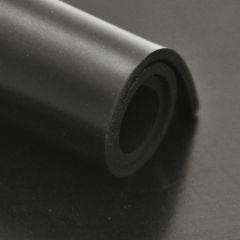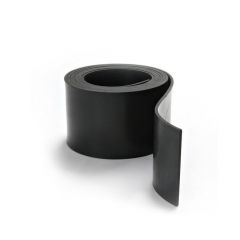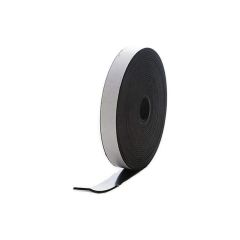EPDM
EPDM rubber sheeting
EPDM rubbers (short for ethylene propylene diene monomer) are special elastomers. These processed ethylene and propylene-based products are highly resistant to oxidation, UV rays and ozone. Because of its excellent weather resistance, this variety of rubber is ideally suited to outdoor applications.
EPDM products are available in several formats and grades. Sheets, rolls, plates, strips, choose the type, width and thickness you require from our stock. For sealing, packaging and protection, EPDM rubber is a safe bet.
EPDM rubber sheeting
EPDM rubbers (short for ethylene propylene diene monomer) are special elastomers. These processed ethylene and propylene-based products are highly resistant to oxidation, UV rays and ozone. Because of its excellent weather resistance, this variety of rubber is ideally suited to outdoor applications.
EPDM products are available in several formats and grades. Sheets, rolls, plates, strips, choose the type, width and thickness you require from our stock. For sealing, packaging and protection, EPDM rubber is a safe bet.
The Uses of EPDM Rubber
Tiles, sheets, rolls, and pads made of EPDM rubber are used in many fields such as construction and automotive.
EPDM rubber is widely used in sealing gaskets, such as O-rings and sealing profiles for the automotive industry, especially for door surrounds and dashboards, as well as for washing machine door skirts. It is also a good material for thermal insulation of parts exposed to cold.
Respirators, such as protective masks for paint spraying in the automotive industry, also use EPDM rubber seals because it offers superior water resistance compared to silicone, which should be avoided in these applications and preferred in case of oil usage. Other examples of EPDM rubber use include laminated glass, garden hoses, tubes, geomembranes, belts, electrical insulation, vibration dampers, solar panels, radiators, heat collectors, and speakers. The energy industry uses EPDM in large volumes, particularly for its resistance to acids and its discreet black profile.
EPDM rubber is also used for protection in electrical cable sheaths, as well as for waterproof roofing/terrace membranes, gutters, and cornices that do not pollute runoff rainwater, which is particularly useful for green roofs and water harvesting. There are also new 3D waterproofing membranes, factory-made with pre-fabricated corner shapes to facilitate installation.
For ornamental pond creation, geomembranes and flexible EPDM rubber tarps are used, installed on a geotextile to allow for the creation of ponds with more natural shapes.
Finally, EPDM rubber can be used to create non-slip and soft floors, by mixing coloured granules with polyurethane binders, to be troweled or sprayed on concrete or asphalt. This technique is particularly used for wet areas and where rainwater could accumulate. It can also be used as a safety surface under children's play equipment to reduce the risk of injury.
Note: To determine the quality of the appropriate rubber, you should always consider the environment in which the product will be used and the requirements it must meet. If in doubt, please contact our customer service at the address below.
Other: If you want to receive custom dimensions, we offer a custom cutting service. Keep in mind the maximum length of the product roll. With Planetcaoutchouc, benefit from the best products at the best price. You just have to select the volume of your parts, their length/size and let yourself be guided.
The Advantages of EPDM Rubber
EPDM rubber is a synthetic material widely used in various applications due to its unique properties. One of its main advantages is its exceptional resistance to wear and chemical/corrosive products, making it a popular choice for sealing gaskets in demanding industrial and marine environments. Additionally, it has good adhesive properties, which facilitates its use in applications where good adhesion is crucial. However, caution should be taken as this rubber is relatively sensitive to oils.
EPDM rubber also has good UV resistance, which allows it to withstand degradation caused by sunlight, as well as durable exterior waterproofing, making it perfect for roofs, terraces, cornices, and gutters. It is also watertight to water vapour, making it suitable for applications where moisture is an issue, such as electrical cable sheaths.
EPDM rubber can withstand extreme temperatures, ranging from -30°C to 100°C, making it an ideal material for applications in hot or cold environments. Additionally, it is resistant to oxidation, allowing it to maintain its mechanical properties and ensure a long service life.
In summary, EPDM rubber is an exceptionally versatile material that can be used in a wide variety of industrial and commercial applications due to its wear resistance, resistance to chemical/corrosive products, good adhesion, UV resistance, durable exterior waterproofing, water vapour tightness, temperature resistance, and oxidation resistance. These properties make EPDM rubber an ideal choice for the most demanding applications where durability, resistance, and reliability are crucial.
For a personalised quote, please contact our customer service at sales@planetcaoutchouc.com. For more technical data on the product such as its maximum length, width, minimum and maximum temperatures, please see the section of the same name below.
The Properties of EPDM Rubber
EPDM rubber properties are varied. EPDM rubber has good resistance to aging. It can withstand temperatures between -30°C and +100°C and is resistant to water and steam. It has good resistance to glycol-ether hydraulic fluids, but is not suitable for contact with petroleum products.
The Characteristics of EPDM Products
Applications
- Outdoor applications
- Automotive industry
- Maritime sector
- Construction infrastructure
Advantages
- Resistant to aging
- Hot water seals
- Custom gaskets
- Temperature range from -25°C to +100°C
- Weather-resistant
- Moisture-resistant
- Steam and water-resistant
- Resistant to UV rays, oxidation, and ozone
Resistances
| Petrol | Poor |
| Lubricating oils | Poor |
| Acids | Excellent |
| Alkalines | Good |
| Hydraulic phosphates | Good |
| Liquid silicates | Average |
| Wear resistance | Good |
| Tear resistance | Average |
| Shock resistance | Good |
| Gas permeability | Good |
| Ozon and UV resistance | Excellent |




















